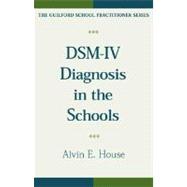
| Introduction: Purposes and Features of This Book | p. 1 |
| What This Book Is--and Is Not--Intended to Do | p. 1 |
| A Guide to Stylistic Conventions in This Book | p. 3 |
| The Four Types of Notes and Their Purposes | p. 4 |
| 2002 Updates: IDEA 1997 and DSM-IV-TR | p. 5 |
| Diagnostic Issues and the Use of DSM-IV | p. 7 |
| Psychiatric Diagnosis: Issues for School Psychologists | p. 9 |
| The Emergence of Psychiatric Diagnosis as a Task in School Settings | p. 9 |
| Psychiatric Classification and Its Role in School Settings | p. 10 |
| Developmental Features to Consider in Diagnosing Children and Adolescents | p. 12 |
| An Overview of the DSM-IV Diagnostic System | p. 14 |
| Basic Definitions of Mental Disorders and Other Conditions | p. 14 |
| Multiaxial Classification | p. 18 |
| Precedence of Diagnoses: Diagnostic Conventions, Hierarchies, and Multiple Diagnoses | p. 26 |
| Child and Adolescent Mental Health and DSM-IV | p. 28 |
| Learning to Use DSM-IV | p. 31 |
| Categorical Classification | p. 31 |
| Differential Diagnosis | p. 32 |
| Ordering of Diagnoses | p. 33 |
| Degree of Diagnostic Confidence | p. 34 |
| How to Record Diagnoses | p. 35 |
| Interpretation of Diagnostic Impressions from Other Sources | p. 36 |
| Guidelines for Evaluation of Presenting Problems | p. 39 |
| Disruptive Behavior Symptoms (Externalizing Problems) | p. 41 |
| Overview | p. 41 |
| Differential Diagnosis | p. 45 |
| Specific Behavior Patterns | p. 48 |
| Emotional Symptoms (Internalizing Problems) | p. 60 |
| Anxiety Problems | p. 60 |
| Mood Problems | p. 77 |
| Other Internalizing Problems | p. 89 |
| Substance-Related Problems, Other "Addictive" Behaviors, and Harmful Environmental Effects | p. 102 |
| Substance-Related Problems | p. 102 |
| Other "Addictive" Behaviors | p. 109 |
| Harmful Environmental Effects | p. 111 |
| Highly Focused Symptom Patterns | p. 114 |
| Eating Problems | p. 114 |
| Tic Disorders | p. 119 |
| Elimination Disorders | p. 120 |
| Miscellaneous Symptom Patterns | p. 121 |
| Sexual and Gender Identity Disorders | p. 122 |
| Sleep Disorders | p. 123 |
| Problems with Mental Ability, Learning, Communication, and Cognition | p. 125 |
| Overview | p. 125 |
| Mental Retardation and Related Problems | p. 126 |
| Learning Disorders and Related Problems | p. 134 |
| Communication Disorders | p. 141 |
| Cognitive Problems | p. 144 |
| Highly Atypical Symptom Patterns: Pervasive Developmental Disorders and Psychoses | p. 148 |
| Overview | p. 148 |
| Pervasive Developmental Disorders | p. 149 |
| Psychoses | p. 154 |
| Personality Disorders | p. 163 |
| Diagnosing Personality Disorders in Youth: Controversy and Cautions | p. 163 |
| Other Cautions about Diagnosing Personality Disorders | p. 165 |
| Cluster A (Odd-Eccentric) Personality Disorders | p. 166 |
| Cluster B (Dramatic-Emotional) Personality Disorders | p. 168 |
| Cluster C (Anxious-Fearful) Personality Disorders | p. 170 |
| Residual Cases | p. 171 |
| Additional Codes and Categories | p. 172 |
| Broader-Band Residual Categories | p. 172 |
| No Diagnosis/Diagnosis Deferred Categories | p. 173 |
| Appendix B: Proposed Categories and Axes | p. 174 |
| The Application of DSM-IV in School Settings: Issues and Topics | p. 177 |
| Ethics and Professional Responsibility in Evaluation | p. 179 |
| The Role of the School Psychologist in Mental Health Assessment | p. 179 |
| Best-Practice Recommendations for School Psychologists Regarding Diagnosis | p. 182 |
| The Case Record: Data and Supporting Documentation for Diagnosis | p. 183 |
| Confidentiality, Freedom of Information, and Parents' and Children's Rights | p. 183 |
| Maintenance of Records | p. 184 |
| Seeking Reimbursement for Assessment and Diagnosis within School Settings | p. 186 |
| Physicians' Current Procedural Terminology Codes | p. 186 |
| "Medical Necessity" as a Criterion | p. 188 |
| Ethical and Professional Responsibilities in Billing | p. 190 |
| Diagnostic Disagreement | p. 192 |
| DSM-IV and the Individuals with Disabilities Education Act | p. 194 |
| Concerns about DSM-IV | p. 197 |
| Concerns about Psychiatric Classification in General | p. 198 |
| Concerns about DSM-IV's Overall Conceptualization and Structure | p. 200 |
| Specific Concerns about DSM-IV | p. 201 |
| Concluding Remarks | p. 203 |
| References | p. 205 |
| Index | p. 225 |
| 2002 Updates: IDEA 1997 and DSM-IV-TR | p. 231 |
| Table of Contents provided by Syndetics. All Rights Reserved. |
The New copy of this book will include any supplemental materials advertised. Please check the title of the book to determine if it should include any access cards, study guides, lab manuals, CDs, etc.
The Used, Rental and eBook copies of this book are not guaranteed to include any supplemental materials. Typically, only the book itself is included. This is true even if the title states it includes any access cards, study guides, lab manuals, CDs, etc.